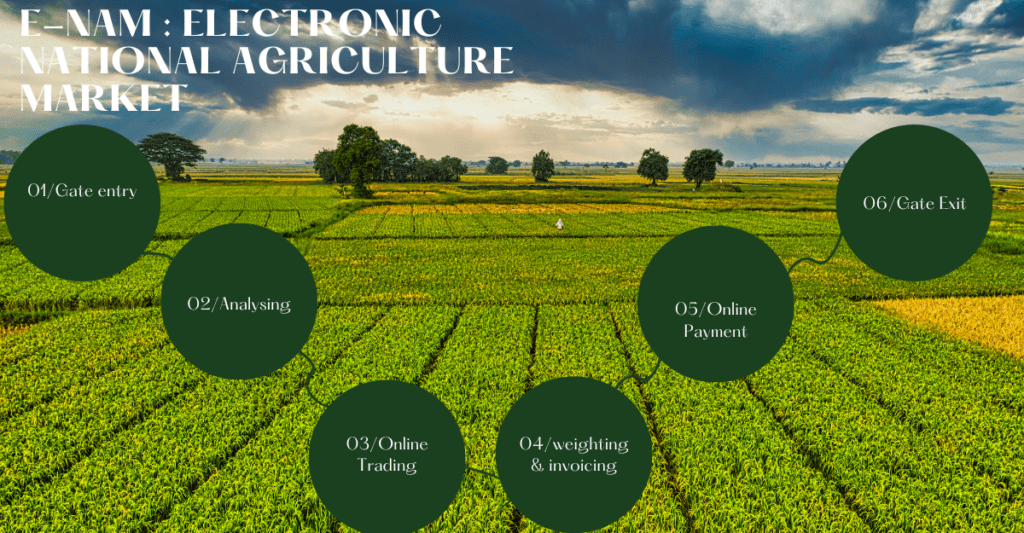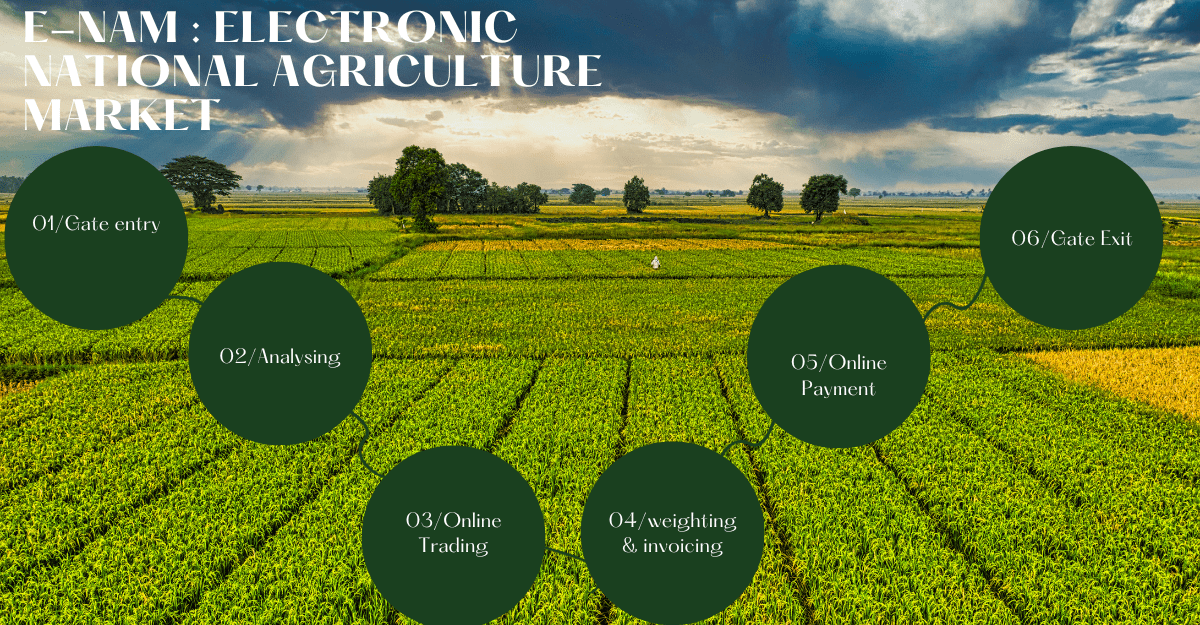
Introduction
The way farmers sell their produce is being subtly changed by a digital revolution taking place in the agricultural heartland of India. For the agricultural industry, the E-National Agriculture Market (E-NAM) is a revolutionary project that has changed everything. This essay delves into the complexities of the E-National Agriculture Market, examining its history, features, advantages, obstacles, achievements, and bright future.
Origins and Significance
The roots of the e-National Agriculture Market can be traced back to 2016 when it was launched with the aim of creating a unified national market for agricultural commodities. The significance of this platform lies in its ability to connect farmers directly with buyers, thereby eliminating middlemen and ensuring fair prices for agricultural produce. It operates as an online trading platform, bridging the gap between farmers and consumers and fostering a transparent and efficient agricultural marketing system.
How E-NAM Works
Understanding the mechanics of the E-National Agriculture Market is essential to grasp its impact. The platform operates on the principle of creating a single market space accessible to buyers from all corners of the country. Farmers and traders can register on the E-National Agriculture Marke platform, providing details about their produce and pricing. Buyers, including retailers, processors, and exporters, can then browse through the listed products and make purchases directly from the farmers.
Registration Process
The registration process for farmers and traders is designed to be user-friendly. It involves:
- Visiting the official (https://enam.gov.in/web/).
- Providing necessary details and documentation.
- Listing the agricultural produce for sale, along with pricing details.
Once registered, farmers and traders gain access to a vast online marketplace, expanding their reach beyond local markets.
Two Benefits of the E-National Agriculture Market
Streamlining Agricultural Marketing
One of the primary benefits of the E-National Agriculture Market is the streamlining of the agricultural marketing process. Traditionally, farmers had to rely on local markets and intermediaries, often resulting in price disparities and delayed payments. With e-NAM, farmers can showcase their produce to a national audience, attracting competitive bids and securing fair prices.
Empowering Farmers and Reducing Intermediaries
The empowerment of farmers is at the core of the E-National Agriculture Market’s impact. By providing a direct link to buyers, farmers can negotiate prices, eliminate intermediaries, and receive timely payments. This empowerment not only enhances the economic well-being of farmers but also contributes to the overall growth of the agricultural sector.
Challenges and Solutions
While the adoption of the E-National Agriculture Market has been commendable, challenges persist, particularly in rural areas.
Connectivity Issues
Many farmers face challenges related to internet connectivity and digital literacy. The government is actively addressing this by investing in rural internet infrastructure and conducting training programs to enhance digital literacy among farmers.
Resistance to Change
Adopting digital platforms requires a shift in mindset, and resistance to change is a common challenge. The government, in collaboration with agricultural extension services, is working to create awareness about the benefits of e-NAM and provide support during the transition.
Lack of Awareness
A significant hurdle is the lack of awareness about e-NAM among farmers. Initiatives such as workshops, seminars, and outreach programs aim to educate farmers about the platform’s advantages and encourage wider participation.
Success Stories
The impact of e-NAM on the lives of farmers is best illustrated through success stories.
Increased Income
Farmers who have embraced e-NAM report a substantial increase in income. The direct connection with buyers ensures that farmers receive fair prices for their produce, leading to improved financial stability.
Reduced Post-Harvest Losses
Efficient and direct transactions through e-NAM contribute to the reduction of post-harvest losses. Farmers can sell their produce quickly, minimizing the time it takes for the products to reach the market.
Improved Market Access
One of the most significant success stories is the improved market access for farmers. No longer confined to local markets, farmers on e-NAM can reach buyers from different states, regions, and even countries.
Future Prospects
The journey of e-NAM is far from over; in fact, it is just beginning.
Technological Advancements
As technology continues to advance, e-NAM is poised to benefit from innovations such as data analytics, the Internet of Things (IoT), and blockchain. These advancements have the potential to enhance transparency, traceability, and overall efficiency in agricultural trade.
Potential Growth and Expansion
The future of e-NAM holds promise for growth and expansion. As more farmers and traders become familiar with the platform and its benefits, participation is likely to increase. The government’s commitment to agricultural reforms and digital initiatives further supports the platform’s potential for growth.
Government Support and Policies
The success of e-NAM is intricately tied to the support it receives from the government.
Digital Agriculture Policies
The government has formulated digital agriculture policies that encourage the adoption of platforms like e-NAM. These policies aim to create an environment conducive to the growth of digital initiatives in the agricultural sector.
Financial Incentives
To motivate farmers and traders to participate in e-NAM actively, the government offers financial incentives. These incentives serve as a reward for embracing digital platforms and contribute to the overall success of e-NAM.
Conducive Regulatory Environment
The creation of a conducive regulatory environment is essential for the smooth functioning of e-NAM. The government’s efforts to streamline regulations related to digital agricultural trade demonstrate its commitment to fostering a favourable ecosystem.
Frequently Asked Questions (FAQs)
- What is e-NAM, and how does it benefit farmers?
- e-NAM, or the e-National Agriculture Market, is an online trading platform that connects farmers directly with buyers, eliminating middlemen and ensuring fair prices for agricultural produce.
- How can farmers and traders register on e-NAM?
- The registration process involves visiting the official e-NAM website, providing necessary details and documentation, and listing agricultural produce for sale with pricing details.
- What challenges does e-NAM face, and how is the government addressing them?
- Challenges include connectivity issues, resistance to change, and lack of awareness. The government addresses these challenges through infrastructure development, awareness programs, and financial incentives.
- Are there success stories of farmers benefiting from e-NAM?
- Yes, success stories abound, with farmers reporting increased income, reduced post-harvest losses, and improved market access.
- What is the future outlook for e-NAM?
- The future of e-NAM looks promising, with potential technological advancements and growth supported by government policies and financial incentives.
Conclusion
In conclusion, e-NAM stands as a beacon of progress in India’s agricultural sector. By leveraging technology to create a unified national market, e-NAM empowers farmers, streamlines agricultural marketing, and contributes to the overall growth of the sector. As the platform continues to evolve and garner government support, its role in shaping the future of agriculture in the country is undeniable.




